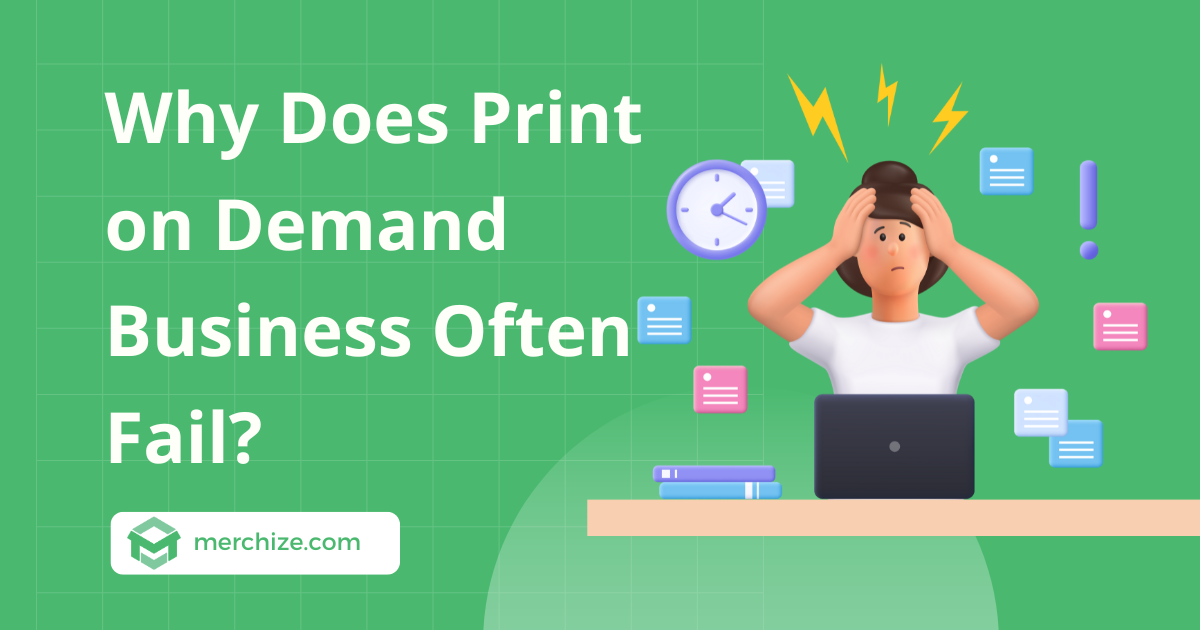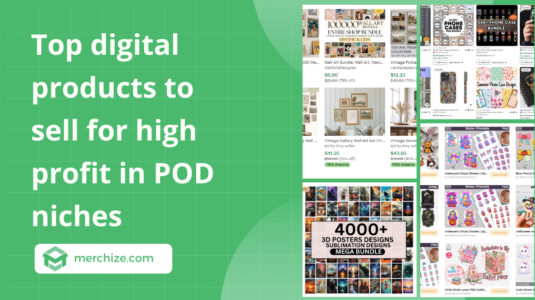It’s estimated that only 1 out of 4 print on demand businesses can survive. Print on demand is clearly not a failure-proof business model that many starters dreamed of. To make your print on demand store successful, you should avoid the following mistake at all costs. These are the common reasons why most print on demand businesses fail.
Reason #1: Lack of Niche Focus
Struggling to define and stick to a niche is one of the most common pitfalls in print-on-demand (POD). It’s easy to believe that casting a wide net will bring in more customers, but the opposite is often true.
Try to appeal to everyone
“If you try to please everyone, you’ll end up pleasing no one.” This one is especially true in print on demand. A generic design that appeals to anyone is what you can easily get at Walmart, Amazon, or any other retail store on- and off-line. There is nothing special that makes the customers want to purchase from you.
Solution: Instead of aiming for “something for everyone,” think about what specific kind of customer you’d enjoy serving. For instance, instead of selling general gifts, specialize in “quirky cat lover merch.”
Select too many niches
Imagine a store offering cat-themed mugs, gym motivational T-shirts, and floral tote bags. What kind of customer would come back for more? Probably none.
People gravitate toward businesses that feel like they “get them.” When your store is all over the place, you miss the chance to build that special connection.
Solution: Choose a single focus. Invest in understanding and serving that audience deeply. And provide all the things that your customers would love to buy.
Target oversaturated niche
Another common mistake is to choose a niche that is oversaturated as a newcomer. In such a niche, there must be hundreds and thousands of sellers before you. They are properly well-established, have a deep understanding of the niche, and provide enough offers to meet the demand. It’s tough to stand out. Predictably, sales struggle and the store fails to gain traction.
Solution: Find a sub-niche or unique angle. For example, instead of “funny teacher T-shirts,” go for “funny science-themed teacher T-shirts.” Tools like EtsyRank or Google Trends can help you discover less crowded spaces. The key is differentiation—make your store the obvious choice for a specific group.
Not test niche’s viability
Finding an undersaturated niche is hard. But when you find one, it’s easy to get overjoyed and jump right in without proper testing just to find out later on that there is not enough demand for this niche.
Launching a line of medieval armor-themed tote bags may seem unique. If your target audience doesn’t want tote bags, you’re in trouble.
Solution: Test your niche before going all in. Create mockups and run a low-cost ad campaign to gauge interest. Platforms like Facebook or Instagram are great for testing ideas. Even a simple survey can reveal whether your niche is worth pursuing.
Not understanding a niche’s audience
Even when you successfully identify the right niche with enough demand and unsaturated supply, you can still fail if you don’t truly understand the customers.
Dive into your niche to understand what type of designs they prefer. For example, a minimalist design might appeal to adult customers but for kids, you must come up with more vibrant, bolder designs that capture the eyes constantly.
Solution: Get to know your audience like a friend. Join Facebook groups, browse Reddit threads, and analyze bestsellers in your niche. Pay attention to their humor, preferences, and shopping habits. Tailor your designs and messaging to reflect what they love.
Reason #2: Poor Product Design
For print on demand products, it’s the designs that sell. Every winning product starts with a good design that looks aesthetically pleasing and speaks to customers’ hearts.
Yet, many sellers failed to deliver good designs. Here are some common mistake that leads to unavoidable design failure.
Create low-quality design
First impressions matter, especially in e-commerce. Low-quality designs signal a lack of professionalism. Customers associate sloppy designs with unreliable products, even if the print quality itself is high. Moreover, a low-quality design wouldn’t stand out, capture the attention of buyers, and convince them to make the purchase.
A low-quality design can come in many forms. It could be obvious like a blurry design, misaligned text, overcrowded layouts, or more subtle like unharmonious compositions, mismatched color schemes, or poor typography choices. Many reasons account for a poor quality design. It takes trained eyes and experiences to spot what exactly is wrong with a specific design.
Solution: Ensure your designs are crisp, visually appealing, and properly formatted for printing. Always test the mockups to catch issues before launching. Quality sells—don’t skimp on it.
Most importantly, if you are not an expert in design yourself, the best way to avoid sloppy designs is to have your design made by professionals. These experienced designers will make sure that the designs look pleasant to the eyes and perfectly deliver your intended messages and styles.
Copy popular design
This is a common mistake in print on demand business: Copying popular designs. Many people think of this as a shortcut to success. However, in reality, it doesn’t play out as well as some might think.
Imagine this: A seller notices that “Mama Bear” designs are trending and decides to replicate the concept. However, their store gets lost in the sea of identical designs, and sales barely trickle in. Worse, they risk legal issues if the original design is copyrighted.
When you copy, you compete directly with established sellers who already dominate the niche. Customers have no incentive to buy from a copycat when they can support the original. Moreover, unoriginal designs lack personality and are misaligned with your own brand, which makes it hard to build a loyal customer base.
Solution: Use trends as inspiration, not as a blueprint. Add a twist—personalization, unique graphics, or a humorous spin. For example, instead of copying the “Mama Bear” shirt, create a playful design using a similar idea with an artistic flair. In other words, differentiate yourself to stand out in the market.
Overuse of text-based design
Text-based designs are popular among print on demand designs. These impactful short slogans make it easy to spread an idea and create instant connections with targeted customers. However, it’s not easy to fully leverage the power of text.
For example, a seller creates T-shirts covered in plain text slogans like “Coffee First” or “Monday Blues”. While text designs are quick to make, they’re often uninspiring and generic when not paired with strong typography or complementary visuals. Such designs rarely excite shoppers enough to click “Buy."
Solution: Elevate your text-based designs with artistic fonts, dynamic layouts, or subtle illustrations. For instance, pair “Coffee First” with a whimsical coffee cup doodle or vintage lettering. Think of text as part of a larger design story, not the whole story.
Make a design that doesn’t connect with customers
Great designs tap into the emotions, values, or identity of the target audience. A generic, irrelevant design doesn’t evoke the “This is so me!” reaction that drives impulse purchases.
A design that simply says “I Love Dogs”, while accurate, won’t sell as it is too generic and lacks emotional depth. It fails to spark the joy or humor that niche audiences crave.
Solution: Dive deeper into your audience’s mindset. For dog lovers, a playful slogan like “The more people I meet, The more I love my dog” or a hand-drawn illustration of specific breeds could strike a chord. Join social media groups or browse forums to see what resonates with your audience. Design with empathy and intention, not just surface-level understanding.
Reason #3: Inadequate Marketing
Marketing isn’t just a sidekick to your print-on-demand business—it’s the lead character. Poor marketing can cause even the best designs to sit unnoticed in a sea of competitors. Let’s explore the common pitfalls, why they hurt, and how to steer clear of them.
Underestimate paid advertising
This truth might shatter a lot of new sellers’ hope: Your print on demand business can’t thrive without paid advertising. Relying solely on organic traffic isn’t sustainable. Organic reach is limited, especially in crowded markets.
Platforms like Instagram and Facebook prioritize paid content, leaving organic posts with lower visibility. Without investing in paid ads, your products may never reach your target audience.
Solution: Start small with paid advertising. Platforms like Facebook, Instagram, and TikTok allow you to set modest budgets while testing which ads work best. Create eye-catching visuals and use precise targeting options (e.g., coffee lovers for mugs with coffee-related designs). Track performance metrics like clicks and conversions to refine your strategy.
Poor product listings
You have everything checked: high-demand unsaturated niche, beautiful designs that are relatable to your audience, and well-executed paid advertising campaigns. But why is the conversion rate still low?
If that’s the case, then you should look at your product listings again. Do you include detailed product descriptions that highlight the great quality of your products? What about the mockup images? Do they do your design justice?
A weak product listing lacks the visual and descriptive appeal to convince someone to buy. Without high-quality photos and compelling descriptions, customers are left guessing.
Solution: Treat your product listing like a sales pitch. Use lifestyle images that show the product in real-world scenarios. Write detailed descriptions highlighting the design’s inspiration, material quality, and fit.
Fail to define a target audience
Marketing to “everyone” is marketing to no one. Generic messaging doesn’t spark interest because it fails to address the unique preferences or problems of a specific group.
A seller creates a line of phone cases with floral designs but markets them to everyone. Their ads lack specificity, saying only “Beautiful cases for anyone!” As a result, the ads don’t resonate, and sales remain sluggish.
Solution: Narrow down your audience. Are you targeting women aged 18–25 who love boho aesthetics, or professionals who want subtle yet elegant designs? Define their demographics, interests, and pain points. Then tailor your ads and listings to speak directly to them. For example: “Elegant floral phone cases designed for busy professionals who want style without bulk.”
Reason #4: Poor Supplier Choices
Choosing the wrong supplier is a fatal mistake to make, especially in print on demand. POD businesses rely heavily on the supplier to provide quality products and timely delivery. A wrong choice here can lead to cracked customer trust and, ultimately, a crumbled business.
Not test product quality before selling
One of the limitations of print on demand business is that sellers don’t control the product quality. To solve this problem, it is highly important to make sample orders and test product quality before selling.
A design might look great in a mockup, but what about the fabric feel, print durability, or sizing accuracy? These questions can only be answered when you have the products at hand and test them.
Poor quality damages your brand reputation faster than you can blink an eye!
Solution: Order samples if you can. Check how the design appears, how the fabric feels, and how it performs after washing. Share photos and videos of these samples on your store or social media to reassure customers of your quality. Think of this as your quality control checkpoint.
Select based on cost and ignore quality and fulfillment time
Chasing the cheapest option can feel like a smart move, but don’t sacrifice the quality and time commitment for the lowest cost possible. Poor quality products and delayed shipping frustrate customers, leading to complaints, returns, and bad reviews. It damages both your business’s profitability and ultimately, customer trust.
Solution: Choose suppliers based on their overall reliability, not just cost. Research reviews from other sellers to gauge print quality and delivery speed. Prioritize suppliers with fulfillment centers near your target market to optimize shipping times and costs.
Reason #5: Underestimating Costs and Pricing
It’s important to keep the balance between competitiveness and profitability. This is where many print-on-demand (POD) businesses trip up. Some sellers price their products too high without deserving perceived values while others push the price too low that they can barely make money.
Here are some common mistakes that print on demand sellers make with their pricing strategy:
Not account all costs
Neglecting hidden expenses is a classic error. Costs such as shipping, platform fees, packaging, transaction charges, advertising costs, and even refund handling can quietly erode your margins. Without a comprehensive breakdown, you’re flying blind.
Solution: Be meticulous with calculations. Include every expense—base product cost, shipping, platform fees, marketing, and even taxes. If you want to lower the price, it’s better to find ways to cut costs to maintain a healthy profit margin.
Offer unsustainable discount
Deep discounts may lure customers. But be careful because they’re a double-edged sword. If your pricing doesn’t account for reduced margins during sales, you risk operating at a loss. Plus, customers accustomed to discounts may hesitate to buy at full price later.
Solution: Use discounts wisely. Offer them sparingly and strategically, targeting overstocked items or seasonal products.
Alternatively, opt for bundle deals or “free shipping over $50” promotions to increase order value without slashing profits.
Most importantly, always calculate the breakeven point for each discount before launching.
Set the price too low or too high
Prices that seem too good to be true can affect your profit margins. Conversely, overpricing without offering added value (like premium materials or unique designs) turns potential buyers off. Finding the right middle ground is crucial.
Solution: Study your competitors. Identify their pricing sweet spots and determine where your product fits. If your price is higher, justify it by highlighting unique features or ethical production practices. If it’s lower, ensure you communicate the value clearly to avoid appearing “cheap.”






